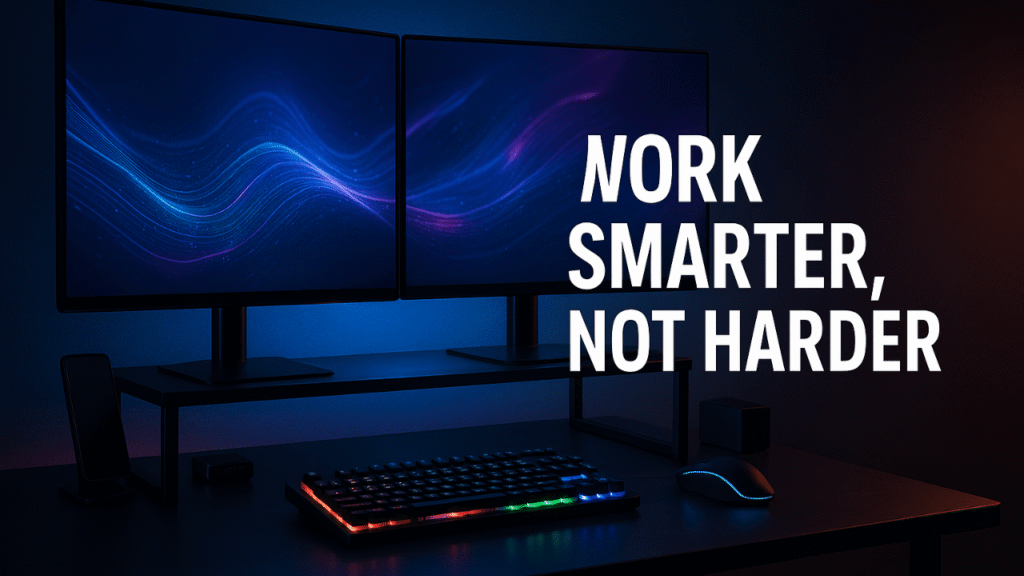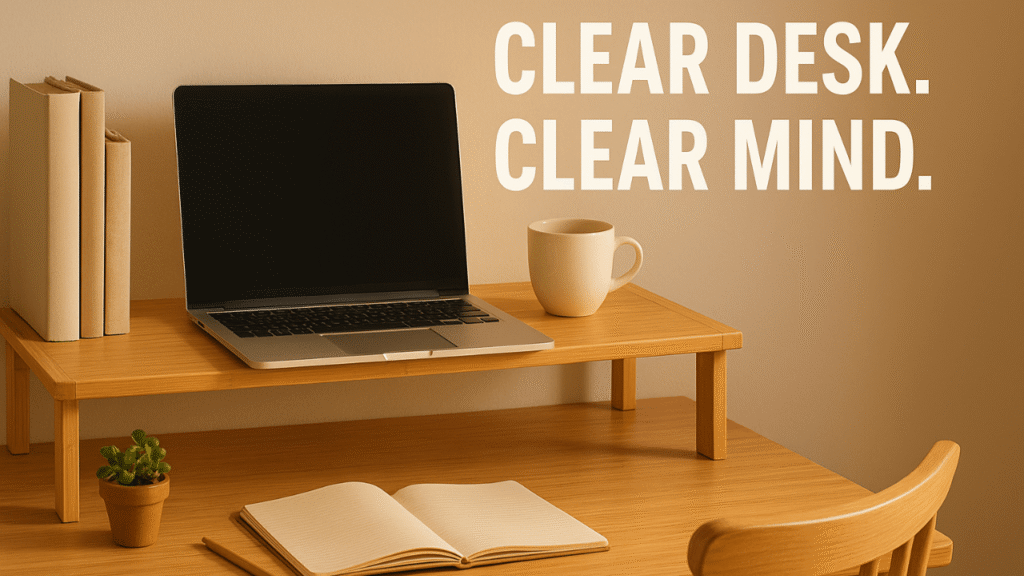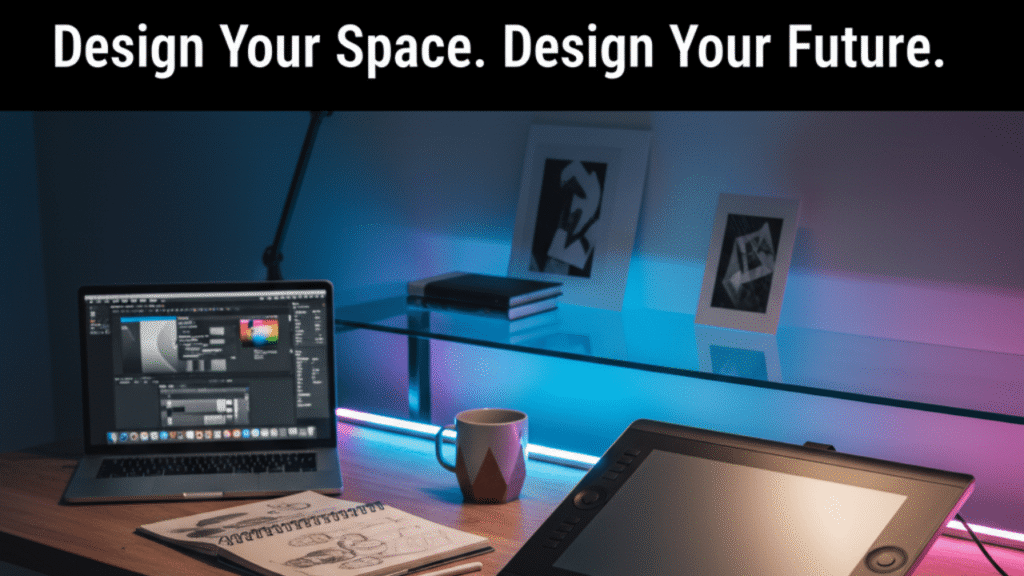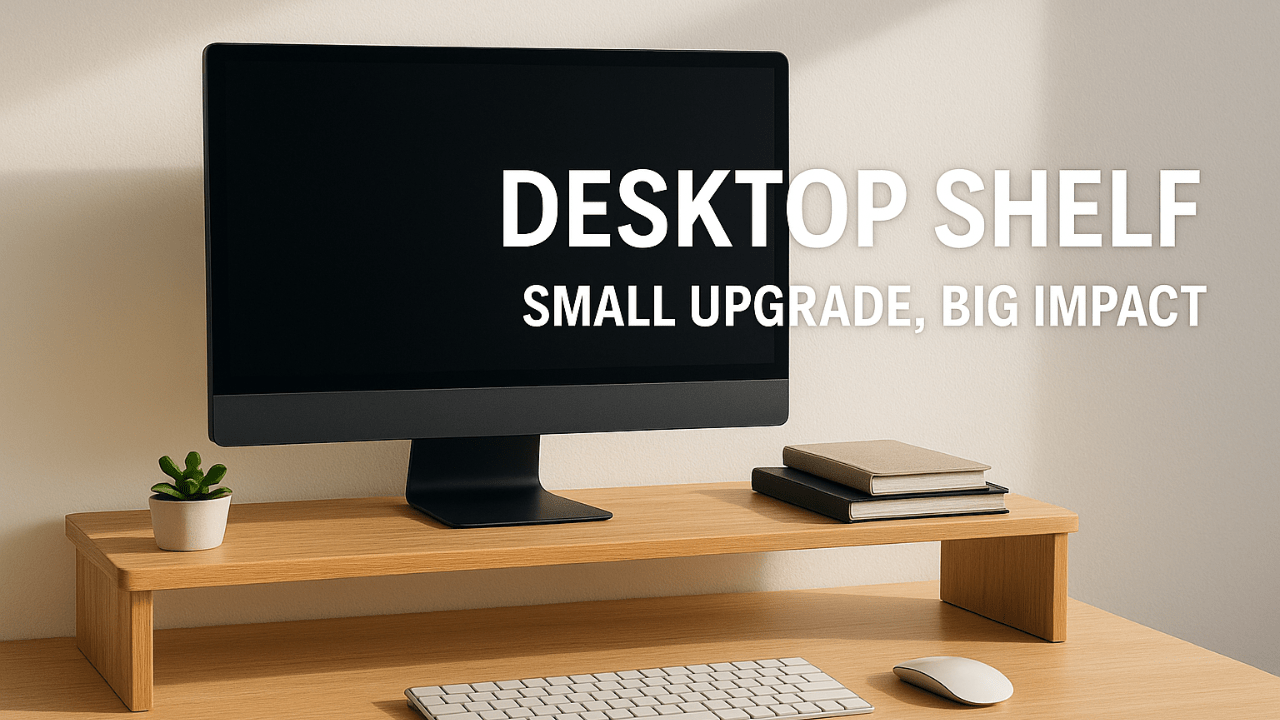Introduction
Clutter creeps in silently, scattering papers, tangled cables, and gadgets across your desk until focus feels impossible. That’s why a desktop shelf is more than just an accessory—it’s a subtle transformation of how you work. By elevating your monitor, laptop, or essentials, it carves out breathing room on a crowded surface. The result is not just tidiness but a shift in how you approach your day.
When you introduce a desktop shelf, you’re doing more than clearing space—you’re signaling intention. You’ve created a work environment that respects order, supports posture, and feels calm the moment you sit down. This small upgrade can shape productivity and even influence how professional your workspace looks.
What is a Desktop Shelf and Why It Matters
A desktop shelf is a simple structure that redefines the way you interact with your desk. Unlike standard organizers that hide things away, it raises your gear into view while freeing the space beneath. This vertical layering keeps the essentials within reach without letting them overwhelm the flat surface. For anyone who feels suffocated by clutter, this design is a game changer.
More than convenience, a desktop shelf directly affects how your body feels during long hours of work. By lifting screens closer to eye level, it helps prevent strain on the neck and shoulders. It’s this ergonomic benefit—paired with psychological clarity—that makes it different from every other desk accessory.
Beyond Storage: The Ergonomic Edge
Posture problems often stem from tiny misalignments. A raised monitor naturally encourages you to sit upright, keeping your neck in line with your spine. Over time, this reduces fatigue, making long hours less punishing. The shelf delivers ergonomic relief without expensive chairs or gadgets.
Mental Clarity Through Physical Order
A messy desk creates micro-distractions every time you glance around. By stacking objects neatly at different levels, you reduce that mental noise. Suddenly, the desk looks calmer, and so does your workflow. This clarity fosters focus you don’t have to force.

Key Benefits of Using a Desktop Shelf
The biggest strength of a desktop shelf lies in its dual role—practical tool and mindset shifter. It clears desk space instantly, giving room for laptops, notebooks, or keyboards to slide underneath. At the same time, it transforms the look of a cluttered surface into something refined and professional. For many, this combination feels like working in an entirely new environment.
Beyond appearances, a desktop shelf can make work feel physically better. Better posture, sharper focus, and reduced eye strain add up to less fatigue. The value comes not from a fancy design but from how it simplifies daily routines. It’s proof that even a small piece of furniture can completely change workflow.
Improved Posture and Reduced Strain
Hours of leaning into screens often end with sore muscles. Elevating a monitor a few inches prevents that forward hunch, giving your body relief. The small shift in height translates into long-term comfort. For many, it’s the first noticeable ergonomic improvement at their desk.
More Desk Space Without Upgrading Furniture
Replacing a desk isn’t always possible, but adding a shelf is easy. It doubles usable space by introducing a second tier. Suddenly, items that once crowded the desk are neatly stored underneath. The surface feels open without changing the furniture itself.
Visual Clarity → Sharper Focus
The human brain thrives on order. A clean desk guides your attention to what matters instead of distractions. By elevating and grouping items, the shelf creates visual balance. This calmness directly translates into better focus throughout the day.
An Aesthetic Upgrade to Any Setup
Practicality doesn’t exclude beauty. Shelves come in finishes that enhance the look of any workspace—wood for warmth, metal for edge, and acrylic for minimalism. The effect is both functional and stylish. It turns a desk into a space you actually want to return to.
Best Desktop Shelf Ideas for Different Workspaces
Not every desk has the same demands, and the beauty of a desktop shelf is its adaptability. Whether you’re working in a small apartment corner or managing multiple monitors, there’s a design that fits. The shelf’s flexibility means it can serve students, professionals, or gamers with equal value. It adapts not only to size but also to style.
A desktop shelf can be as subtle as a slim riser for a laptop or as bold as a wide structure holding dual monitors. Each setup benefits in unique ways, proving that this accessory is not one-size-fits-all. It’s about tailoring the desk to match specific needs.
Minimalist Home Office Setups
In small workspaces, simplicity matters. A slim riser clears just enough room for a keyboard or notebook to slide beneath. It adds structure without cluttering the surface. The result is a cleaner, more breathable home office.
Dual-Monitor or Tech-Heavy Desks
Heavy setups need more than elegance—they need stability. Wide shelves built for two monitors provide balance and extra room for hubs or external drives. This keeps gear aligned while preventing overcrowding. The desk feels organized instead of weighed down.
Student Study Zones
Students balance digital tools with physical books. A compact shelf makes that switch easier by separating textbooks from devices. It encourages organized study habits while keeping everything accessible. Even a small shelf can transform cramped dorm desks.
Creative or Gaming Setups
Creatives and gamers demand function with flair. Sturdy shelves with sleek finishes or cable cutouts meet those needs. They create room for accessories while adding style to the setup. The result is both practical and visually striking.

How to Choose the Right Desktop Shelf
Finding the right desktop shelf comes down to knowing your workspace. The wrong size or weak materials can cause frustration instead of improvement. That’s why strength, proportion, and design matter equally. A good shelf feels like it belongs on your desk instead of sitting awkwardly on top.
A desktop shelf should also align with your workflow. Adjustable models allow flexibility, while fixed designs provide long-term stability. Choosing carefully means you’re not just buying furniture—you’re investing in comfort and efficiency.
Materials and Durability
Wood delivers warmth and strength, metal provides industrial toughness, and acrylic offers a sleek, modern look. Each has trade-offs in durability and style. The choice should reflect both function and personality.
Size and Weight Capacity Considerations
Too small, and it won’t fit your setup. Too weak, and it won’t hold your gear. Checking measurements and weight limits avoids these pitfalls. It ensures the shelf lasts as long as the desk itself.
Adjustable vs. Fixed Models
Some desks change often; others stay constant. Adjustable shelves offer flexibility for evolving setups. Fixed ones feel sturdier but lock you into one configuration. It’s about choosing what fits your work habits.
Matching Style with Functionality
A shelf isn’t just utility—it’s part of your environment. Matching finishes and designs with your desk creates harmony. When style meets function, the workspace feels both effective and inspiring.
DIY Desktop Shelf Projects (Optional Section)
Not every solution needs a shopping trip. A DIY desktop shelf can be built with simple materials, giving you full control over size and features. The best part is the personal satisfaction of crafting something that fits your exact needs. It’s a project that pays off both practically and creatively.
The appeal of building your own goes beyond cost savings. A DIY desktop shelf can include custom cable cutouts, hidden storage, or finishes that match your room perfectly. With a little effort, you end up with something unique—tailored to your workflow in ways store-bought shelves rarely are.
Quick-Build Weekend Ideas
Even basic boards and riser legs can create effective shelves. These quick builds don’t require complex tools but still deliver real improvements. A few hours of work can make the desk feel brand new.
Customization Tips (Paint, Cable Holes, Hidden Storage)
Drilling holes for cables or adding compartments for stationery elevates function. Paint or stain adds polish and matches the desk’s style. Small touches make the DIY project feel professional.

Top Desktop Shelf Picks in 2025
The market has evolved, and a desktop shelf today is smarter than ever. Beyond simple risers, models now come with charging pads, USB ports, and built-in drawers. This blend of technology and design makes them more versatile than traditional desk accessories. The options available cater to every budget and style.
Choosing the right desktop shelf in 2025 is about finding the balance between value and innovation. Affordable models solve core problems, while premium shelves add elegance and advanced features. No matter the choice, each version reshapes the way a desk functions.
Best Budget-Friendly Options
Low-cost risers made from bamboo or MDF deliver noticeable improvements without draining your wallet. They’re widely available, practical, and perfect for first-time users. Despite their price, they create a significant workspace upgrade.
Premium & Stylish Designs
Solid hardwood or engineered metal shelves bring weight and sophistication. These designs feel substantial and add an element of luxury. They elevate both function and appearance in ways cheaper models can’t.
Tech-Integrated Shelves (Wireless Charging, USB Ports)
Modern workspaces demand more than just storage. Shelves with wireless chargers and built-in hubs reduce cable clutter while powering devices. They combine sleek looks with everyday convenience.
Pros and Cons of a Desktop Shelf
Like any upgrade, a desktop shelf brings both benefits and challenges. The positives are clear: more organization, better posture, and a cleaner aesthetic. These improvements alone make it a must-have for many. But it’s important to weigh the trade-offs.
For smaller desks, a desktop shelf may feel bulky, or it may tempt users to pile too much on top. It also requires an upfront cost, though often far less than replacing furniture. In most cases, the pros outweigh the cons, making it one of the simplest yet most impactful workspace improvements.
Pros: Organization, Ergonomics, Space-Saving, Style
A well-placed shelf gives structure to chaos, reduces strain, and opens more room to work. It also adds style that transforms a desk into something you’re proud to use.
Cons: Added Cost, Fit Limitations, Over-Stacking Risks
Not every desk has space to spare. Costs can add up, and careless stacking may turn order back into clutter. Awareness prevents these pitfalls.

FAQ: Desktop Shelf Questions Answered
Is a desktop shelf worth it for small desks?
Yes. Even compact risers make tight spaces more functional by creating hidden storage and freeing the surface.
Can it support dual monitors?
It depends on the build. Reinforced, wide designs handle the weight easily, but flimsy models may wobble.
What’s the best material for durability?
Solid wood and metal are most durable, while acrylic works for lightweight setups. The best choice depends on usage.
Does it actually improve posture?
Absolutely. By lifting screens to eye level, it naturally reduces neck and shoulder strain over time.
Are DIY shelves reliable compared to store-bought ones?
Yes, if made with quality materials. DIY offers customization but requires precise measurements and sturdy construction.
Conclusion
A desktop shelf is proof that small upgrades can have outsized impact. By creating order, improving ergonomics, and elevating style, it transforms any desk into a tool for better work.
The real power lies in how it changes your relationship with your space. Instead of fighting clutter, you gain a calm, intentional environment. A desktop shelf doesn’t just support your desk—it supports your focus, creativity, and energy every single day.


1 thought on “Desktop Shelf: The Simple Upgrade That Transforms Your Workspace in 2025”